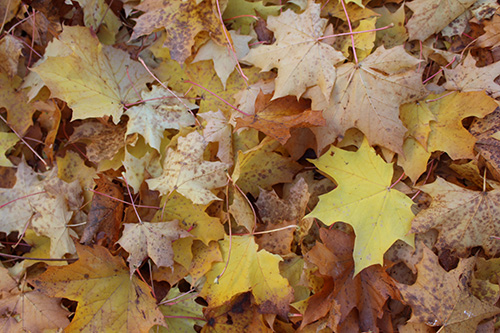
The Two Mile Ash Environmental Group is now in its fifth year and our drive to improve and enhance the environment of Two Mile Ash continues. We continue to care for the areas that we have already worked on, as defined in our Environmental Projects Plan, but we couple this with some new ventures both inside and outside the eight areas in that Plan. Thus, in this autumn season we have pursued bulb planting within our central grassed areas; in Kepwick we are gradually developing a linear garden; in the Ash Brook corridor we are creating a Friends of the Earth inspired ‘Bee World’ and we have put up some thirty bird boxes. The collection of ‘news stories’ that follows seeks to give a flavour of our mixed programme of work between October and December. We hope that you enjoy reading them!
Bulb planting in the village centre
The following piece by Lin Healey records the experience of TMAEG’s first coffee morning which provided the funds for the planting of daffodil and tulip bulbs in the very heart of Two Mile Ash.
Ann Gaunt suggested that it would be nice if the group had a Coffee Morning to raise money to buy Spring bulbs to give more colour to our planted areas. She had visited my house many years ago, when our children were very young and Two Mile Ash was in its infancy. This new venture was agreed, and we had a very pleasant, sociable time with hot drinks, home-made cakes, a plant swap stall and around 25 visitors, raising around £65. A small group was then put together to plan the bulb planting.
We had hoped initially to buy crocuses to plant alongside the paths in the central newly grassed area behind the shop. The idea was to continue the theme of yellow crocuses which always look such a picture in the Spring, opposite Ashbrook School’s main entrance. Unfortunately the crocuses were all sold out but we did buy orange tulips, and narcissi (daffodils) at much reduced prices and we drew up and agreed a planting scheme for these.
On a dry but very windy Saturday in early December, we cut and lifted turfs and planted almost 600 bulbs, spurred on by Pavla’s coffee and Margaret’s rock cakes! A second phase of our work (separately funded) involved tidying the planters in the entrance to the Local Park and replanting the tubs outside Ashbrook School with daffodils. A separate task of planting and managing trees at the back of the Park was also completed. We had a great sense of achievement and a very happy and productive morning. We plan to add more crocuses next year to what we hope will be a lovely colourful show.
Lin Healey
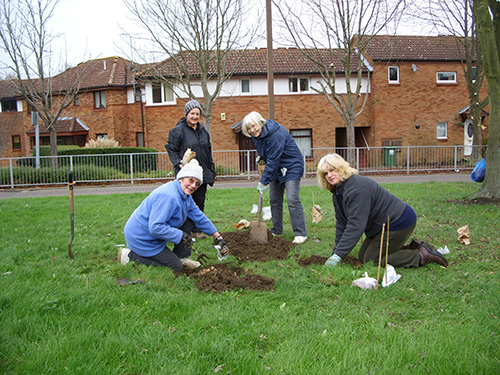
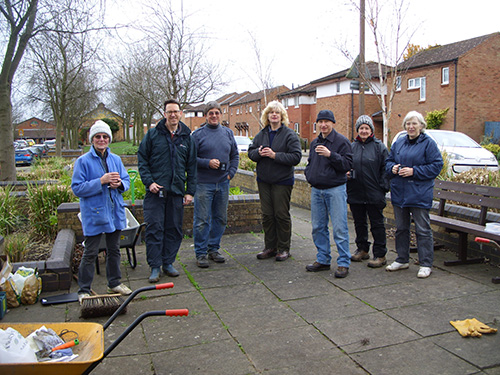
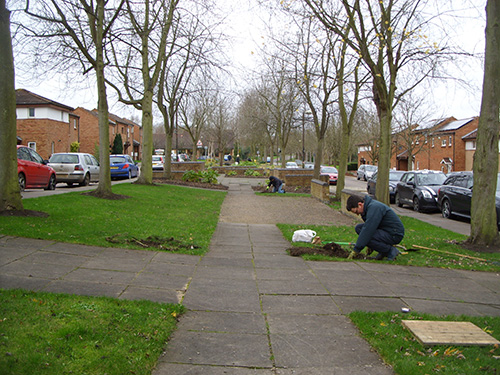
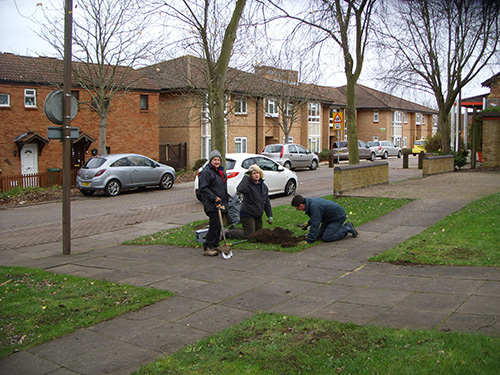
Continuing our work with Ashbrook School
Our partnership with Ashbrook School now extends to three areas of work. First, and perhaps foremost because of its direct educational value, there is the bulb planting experience that has been offered over five years for each child who enters the school. Our thanks go to everyone who makes this possible. Second, we have provided, and help maintain, the planters within the school forecourt area. Now owned by the school, these were recently replanted by TMAEG with February Gold daffodils (see the previous news story). The third part of our partnership concerns the area of landscaping along the High Street side of the school and this is regularly maintained by TMAEG volunteers. Some recent work here is depicted below.
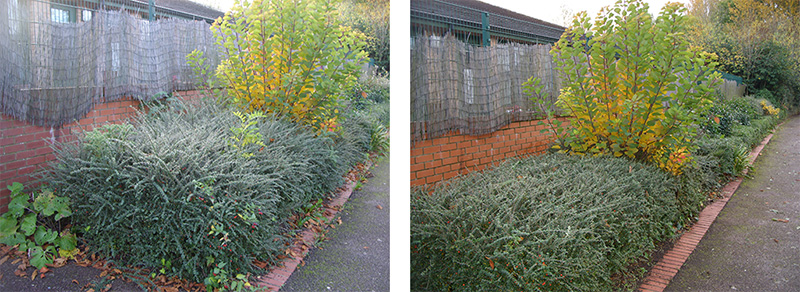
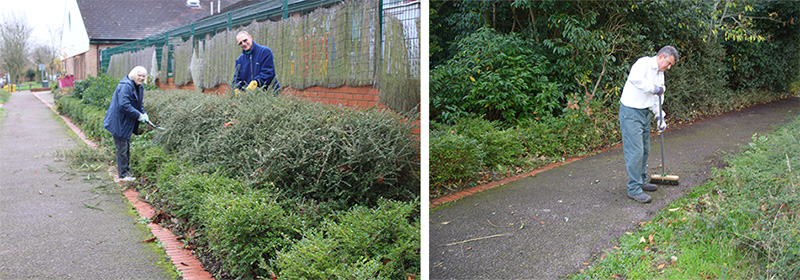
Kepwick – developing a linear garden
TMAEG volunteers have been working for the last three years on various sites in Kepwick. Of these, the most challenging has been the narrow strip of sloping land alongside the footpath to Capian Walk. The soil has a lot of clay in it, making it hard to dig, and this autumn’s frequent wet weather has made the ground very sticky.
At the same time the footpath is well used, particularly as part of a route to and from Great Holm. The adjacent strip is therefore prominent to many people, one of the factors that has encouraged us to persevere with this site this season. As the pictures show – despite the weather – we have made a good start in weeding this land, and this has been followed by the planting of several clusters of tulips and daffodils. A possible scheme to supplement the bulb planting with suitable ground cover, and perhaps some shrubs, is being considered by the TMAEG committee.
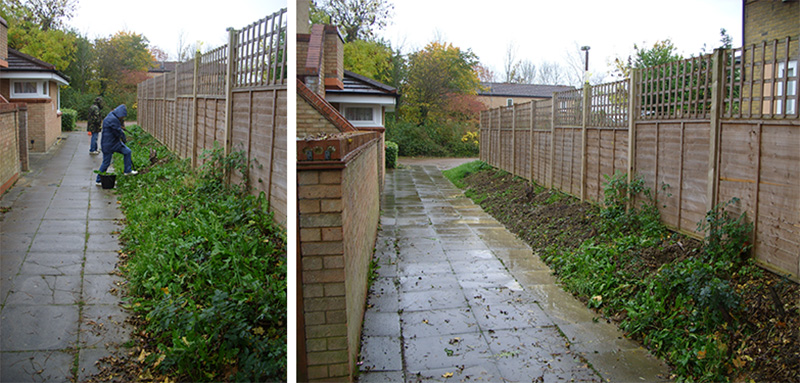
Milesmere – a new glade for wildflower bulbs
On the 17th October a TMAEG working party carried out Autumn maintenance of the Milesmere Woodland Path clearing overgrowth from the edges and from a 1m wide margin on either side of the path. We also created a small glade at a bend in the path where we planted Spring bulbs – wild bluebells, wild daffodils and wood anemones. Also the first of TMAEG’s bird boxes was put up on a nearby tree.
Angela Austin
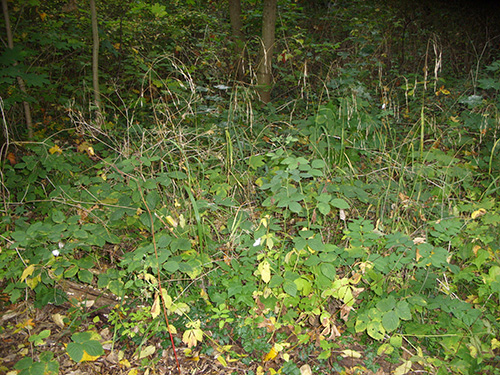
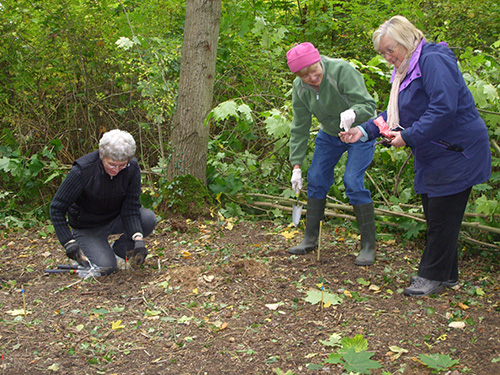
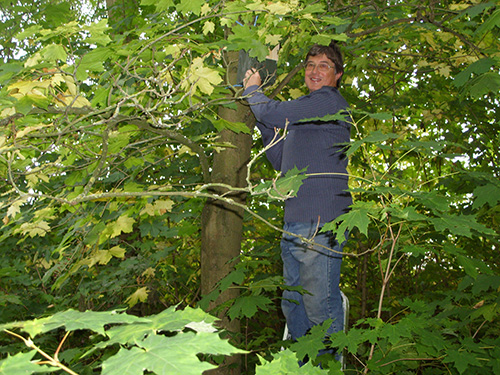
More information on the bird boxes programme appears in the final part of this posting.
Post script – Shortly before these news stories were posted, considerable tree felling and also shrub removal has been carried out within the woodland. We are told by Milton Keynes Council that the reason for the tree felling, which is confined to poplars, is that these trees have been damaged and rendered potentially unsafe through the activities of the clear wing hornet moth – this large, and rarely seen, insect bores into the trunks of poplar species to lay its eggs, and this and the exit holes created by the moths’ young produces hollows which collectively weaken the tree.
Inevitably, the tree felling has had a considerable impact upon the character of the woodland and we must hope that the removal of the fast growing poplars will allow the canopies of the other tree species to spread more quickly, and at least partially compensate for the loss of the poplars.
Our new glade appears unaffected and while the footpath remains useable, some limited damage has been done in places. TMAEG will seek early next year to repair the route where needed, making use of logs from the felled trees, and to resurface it with new chippings.
The Ash Brook Corridor
Not surprisingly because of its scale and the opportunities it presents, we spend more time on this corridor than in any other of our project areas. So this autumn we have been tending the trees that we planted as part of The Big Tree Plant two years ago, we have planted wildflower bulbs in a couple of locations and, as an innovation for this year, we have put up many bird boxes. We also carried out the annual maintenance of the Stone Hill pond, clearing out branch and leaf debris and tending the immediately surrounding area. This is a semi-natural area and we try to keep a careful balance between, on the one hand, having a tidy environment that is safe for its human users and, on the other, the many ecological considerations, for example the need to maintain reasonable cover for birds. Where we can we seek to enhance the biodiversity of the area through appropriate wildflower planting and this year we have introduced another native plant, the wild daffodil.
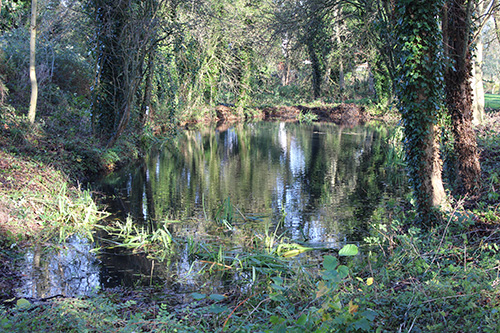
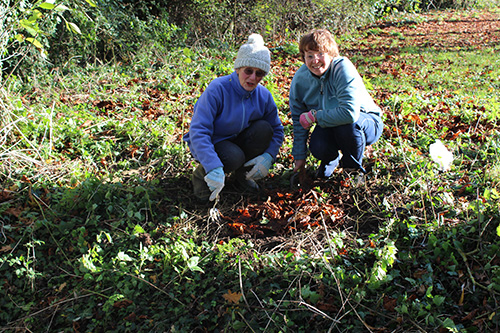
Helped by the volunteers of Milton Keynes Green Gym ( the group led by TMAEG chair Dave Barratt) we have tackled two new sites this year. First we have carried out a major clean up of an area of land at the triangular junction of two paths, the main footpath between Stone Hill and the High Street and the route that crosses it, linking Fennymere with Haithwaite. Under its canopy of alder trees, ‘the Triangle’ as we have begun to call it had become overgrown and infested with brambles and it has benefited from a substantial clear out and trim.
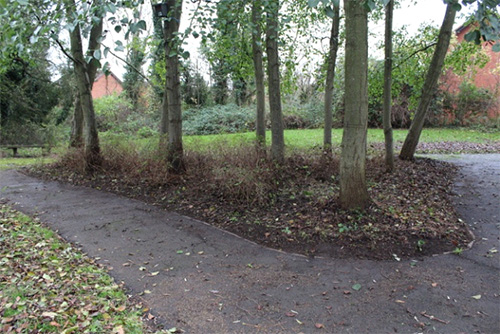
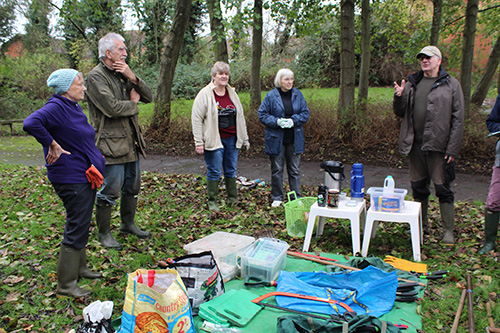
The second new scheme involves land on the sunnier side of the brook, across the footbridge towards Haithwaite. Encouraged by two of our members, Michael and Ferial Hyde, a start has been made on the creation of a small ‘meadow’ area to support bees, butterflies and other insects. This is inspired at national level by a Friends of the Earth project to protect and and encourage bees in the face of the worrying reduction in their numbers nationally.
Our ‘Bee World’ will support numerous floral species that will provide food for bees throughout coming summer seasons. Hopefully the first results will be apparent as early as next year.
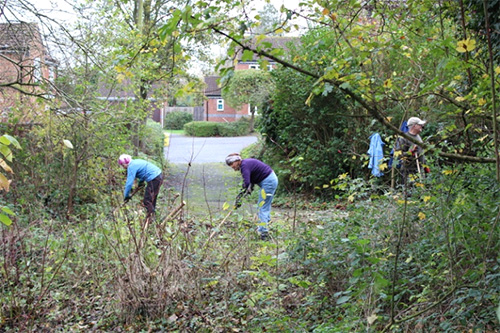
Bird Nesting Boxes for TMA
We finish with a scheme that is likely to have a significant wildlife benefit for Two Mile Ash. This is described by project officer Peter Blyth.
Many residents in TMA have gardens and we are fortunate to have lots of trees and hedgerows which attract a wide variety of wild birds. Having purchased bird feeders a couple of years ago, I continue to be pleasantly surprised seeing the many daily visitors throughout the entire year, including various tits, greenfinches, spotted woodpeckers, chaffinches and, my all time favourite, goldfinches.
Goldfinches are beautifully coloured and their song is almost like a canary. Clearly by our action to maintain a year-round source of food, they have made TMA their home and in order to encourage even more of these small birds, I suggested to TMAEG that we give thought to erecting nesting boxes.
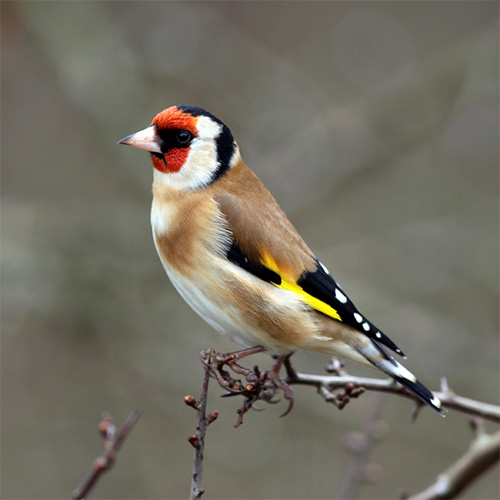
During the early summer, Chris Gossop and I visited Men-in-Sheds in Kiln Farm who had previously manufactured some bird boxes. This group of hobbyists enjoy restoring and fabricating lots of items often from scrap wood. Their workshop is large and fitted out with lots of tools and equipment and their premises are supported by MK Council. We wanted to procure at least 30 boxes and we agreed a price/donation – the proceeds would be used to replace some tools and materials. We just needed funds so TMAEG decided to seek sponsorship from Abbey Hill Parish Council.
After attending a few meetings and making a written proposal to the Parish Council we were pleased to have our proposal accepted and we received half our required funds from the Parish Council with the balance coming from a community fund held by David Lewis, who serves on both the Parish and MK Councils. We are extremely grateful to both the Parish Council and to Councillor Lewis for providing these funds without which the project would not have proceeded.
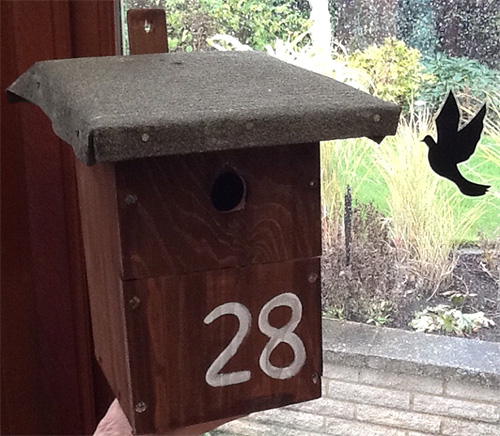
Once the boxes had been collected from Men-in-Sheds, they were painted in a wildlife-safe protective woodstain and numbered. The boxes benefit from hinged lids which means they can be inspected and cleaned out in future. The tops are secured shut for protection using cable ties that can be cut then easily replaced. In order to avoid damaging trees or introducing disease, it was agreed that we would tie the boxes to trees rather than use nails or screws. Because trees grow, it was necessary to use a large diameter weather-resistant cord and tie loosely whilst siting the boxes securely. As the trees grow the cord would not strangle the trunks and thereby allow for many years of growth before adjusting.
The boxes have been located in suitable sites, using NSPB recommended heights and guidelines; they are mainly located within the green corridors and other sites shown on our Environmental Projects Plan. A few boxes have open fronts rather than a hole, which robins and wrens require and as they have to be located at 2 metre, or less, height in dense hedging, these were fitted in locations that were very well hidden – also difficult to access.
With so many Magpies in MK, and a few colourful Jays, our small birds have a tough time raising their young so by providing safe housing more generations of these fascinating birds should survive and I do hope that some goldfinches will make our boxes their homes.
Peter Blyth